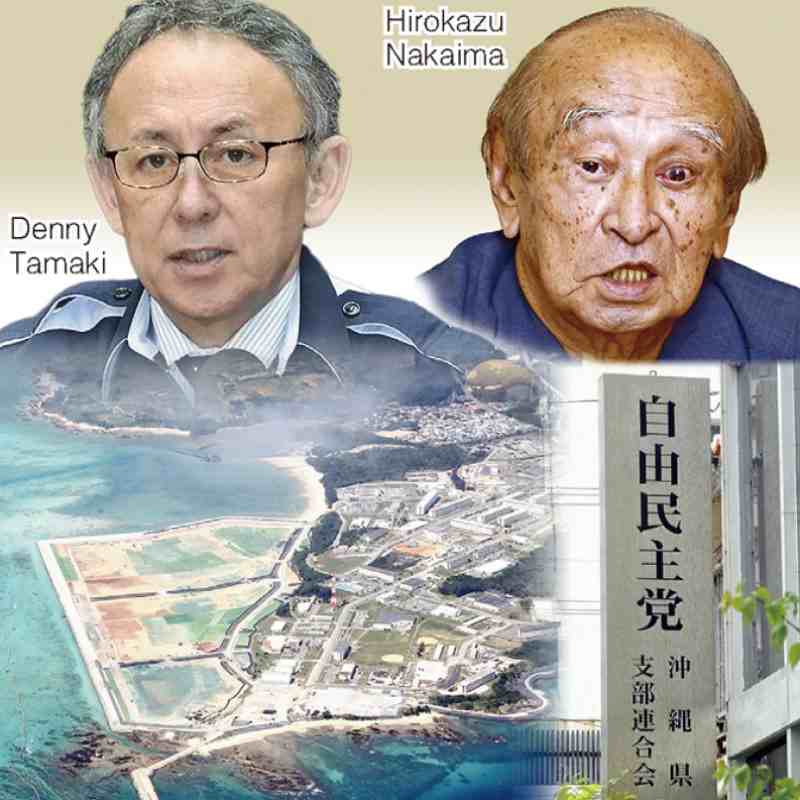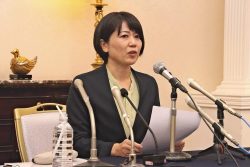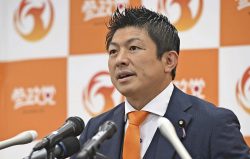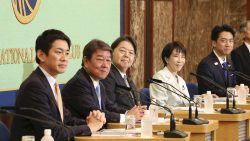
11:47 JST, July 1, 2021
This is the fourth installment of a series looking at various aspects of Okinawa today, 50 years since Tokyo and Washington agreed on its return to Japan.
“You must form a selection committee. You ought to decide on a candidate quickly.”
Around the end of the Golden Week holiday period in early May, there was a call to the cell phone of Kyoki Nakagawa, head of the Liberal Democratic Party’s Okinawa prefectural chapter. It was from a supreme advisor to the chapter, former Okinawa Gov. Hirokazu Nakaima. Speaking quickly, Nakaima gave his instructions regarding the next Okinawa gubernatorial election, slated for the autumn of 2022.
About 6½ years have passed since Nakaima lost his gubernatorial reelection bid in 2014. Nakaima has grown anxious about the fact that the LDP chapter hasn’t decided on a conservative candidate for the upcoming gubernatorial race.
Within the prefectural chapter, several names, including a former mayor and a business leader, are on the list of candidates for next year’s gubernatorial election. Even with the election more than a year away, Nakaima and others have become restless because they believe that ever-growing criticism of current Gov. Denny Tamaki offers a big chance for the LDP to win back control of the prefectural administration.
On May 18, executives of the Okinawa Hotel Association — including their leader Chokei Taira, who is also chairman of Kariyushi Group, a leading hotel chain operator in the prefecture — paid a visit to the offices of the prefectural government.
Taira handed Vice Gov. Yoshimi Teruya, who met with the visitors, a written message for Tamaki. It was a request calling for the establishment of a system of support measures for the hotel industry, making use of such systems as special grants to deal with the new coronavirus that were established in late April by the central government.
The COVID-19 pandemic has devastated tourism, a key industry for the prefecture. The number of holidaymakers visiting Okinawa Prefecture in fiscal 2020 plunged by 72.7% from a year earlier. With hotels closing one after another, one hotel operator even put a newly built hotel up for sale.
Taira, who himself has sold off two hotels in Naha, vented his discontent, saying: “Gov. Tamaki has been responding poorly to the damage inflicted on the tourist sector. He has little interest in it. This is undoubtedly a recession brought about by the prefectural administration.”
“Recession brought about by the prefectural administration” was a phrase often heard in the prefecture when then Okinawa Gov. Masahide Ota confronted the central government over such issues as the relocation of the U.S. Marine Corps’ Futenma Air Station in Ginowan. The confrontation adversely affected the central government’s measures to promote Okinawa. Ota was defeated in the 1998 gubernatorial race by conservative rival Keiichi Inamine.
The LDP Okinawa chapter aims to repeat that history.
Tamaki, while understanding the anguish of Okinawa businesses, has been caught in a dilemma between preventing infections and promoting the local economy.
At an April 8 meeting, senior officials of the prefectural government discussed whether to ask the central government to impose emergency-level priority measures to curb the spread of novel coronavirus infections.
Prefectural government officials, including Tsuguyoshi Miyagi, director of the department of culture, tourism and sports, explained the situation of the tourism industry, which has been devastated by the effects of the pandemic. They made such remarks as, “The operators of accommodations in the prefecture have now been caught in a difficult predicament.”
Tamaki said: “I do know that the tourism industry has been hard hit. But there is a need to prevent infections from spreading.” He thus decided to apply for the emergency-level priority measures.
If the restrictions were eased and infections spread further, he would come under fire from the people of Okinawa. But if the restrictions were tightened, he would face fierce pressure from the tourism industry.
In the end, the central government applied the priority measures to Okinawa on April 12, and declared the prefecture to be in a state of emergency — which is still in effect — in late May.
Framework shaken
In fact, Tamaki’s position had been shaken even before the COVID-19 pandemic hit the prefecture.
In the previous gubernatorial election, held after the death of incumbent Gov. Takeshi Onaga, Tamaki was elected with the support of what is called the “All Okinawa” framework (see below), meaning forces that had come together in a united front in support of Onaga. They came mainly from the left, but to some extent from the right. Even some in Okinawa’s business circles came to support Tamaki.
That some conservatives were able to join hands with leftist forces, after being fiercely at odds with them for many years, is partly due to the charisma of Onaga, who was also the secretary general of the LDP’s Okinawa chapter.
Tamaki, on the other hand, belonged to a non-LDP party during his years as a national legislator, beginning when he was first elected to the House of Representatives in 2009 on the ticket of the then Democratic Party of Japan.
Conservative members of the prefectural assembly and business leaders in the “All Okinawa” framework, who had ideological differences with the leftists all along, began distancing themselves from Tamaki.
The major points at issue during the 2022 gubernatorial election are expected to be whether to approve the relocation of the Futenma Air Station to the Henoko district in Nago, and the economic rehabilitation of Okinawa from the COVID-19 pandemic.
Tamaki has attempted to block the relocation by wielding his gubernatorial authority regarding such matters as the necessary landfill work. Conservatives who approve the relocation are also expected to point to its economic benefits, advocating the earliest possible return of the land where the Futenma base stands in a densely populated district.
As local elections are also slated for 2022, including mayoral races in Nago and Ginowan, the prefecture is in for a tumultuous political year with those on the left and the right fighting a multifront battle for leadership.
Left-right struggle
In Okinawa, left and right have been at loggerheads for many years over leadership of the prefectural government.
The long-standing confrontation has its roots in three major elections held in 1968, before the 1972 reversion of Okinawa to Japan: an election for the position of chief executive of the government of the Ryukyu Islands (equivalent to the present-day governor), an election of the members of the legislature (equivalent to the present-day prefectural assembly) and the Naha mayoral election.
The structure of conflict, in which the conservatives aligned with the LDP fought with the “reformists’ joint struggle committees” of the left, is also called the “1968 system.”
In the election for the position of chief executive, Chobyo Yara, a reformist who appealed for an “instant, unconditional, and total restitution” of U.S. military bases, won the race. Yara also won the first Okinawa gubernatorial election, held following the return of Okinawa in 1972.
In Okinawa gubernatorial elections over the decades to follow, the structure of conflict continued. Changes of government took place repeatedly, with leftists highlighting their opposition to the U.S. military bases and calling for the return of the land to Japan, and conservatives trying to help the local economy develop through measures to promote Okinawa, coordinating their efforts with both the Japanese and U.S. governments.
There is a tendency in Okinawa gubernatorial politics that when the focus is on “the economy,” the conservatives win, but when it is on “the bases,” the leftists win.
The emergence of the “All Okinawa” phenomenon in the 2014 gubernatorial election, which Onaga won, appeared to alter the structure of the confrontation. But now politics in the prefecture are falling back into the old pattern of conflict between left and right.
‘All Okinawa’ framework
“All Okinawa” is a general term for those arguing against the relocation of the U.S. Futenma Air Station to the Henoko district of Nago and also against the use of Osprey aircraft. Many of those in this camp are on the left, although some conservatives have joined hands with them.
"Politics" POPULAR ARTICLE
-

Japan to Support Central Asian Logistics Route That Bypasses Russia, Plan to Be Part of Upcoming Summit in Tokyo
-

Japan to Tighten Screening of Foreigners’ Residential Status by Providing Information of Nonpayment of Taxes
-

Chinese, Russian Bombers Flew Unusual Path by Heading Toward Tokyo; Move Likely Meant to Intimidate Japan
-

Japan Plans National Database to Track Foreign Ownership of Real Estate, Land as It Weighs New Rules
-

Up to 199,000 Deaths Estimated From Mega-Tsunami; Most Recent Occurrence Took Place in 17th Century
JN ACCESS RANKING
-

Tokyo Economic Security Forum to Hold Inaugural Meeting Amid Tense Global Environment
-

Keidanren Chairman Yoshinobu Tsutsui Visits Kashiwazaki-Kariwa Nuclear Power Plant; Inspects New Emergency Safety System
-

Imports of Rare Earths from China Facing Delays, May Be Caused by Deterioration of Japan-China Relations
-

University of Tokyo Professor Discusses Japanese Economic Security in Interview Ahead of Forum
-

Japan Pulls out of Vietnam Nuclear Project, Complicating Hanoi’s Power Plans



























